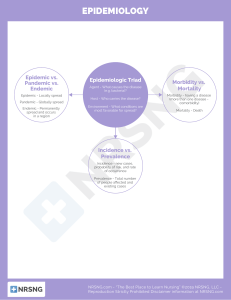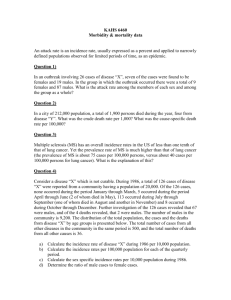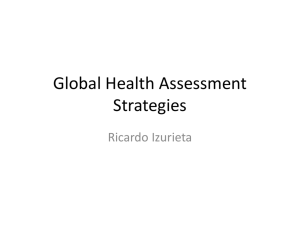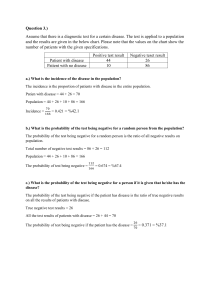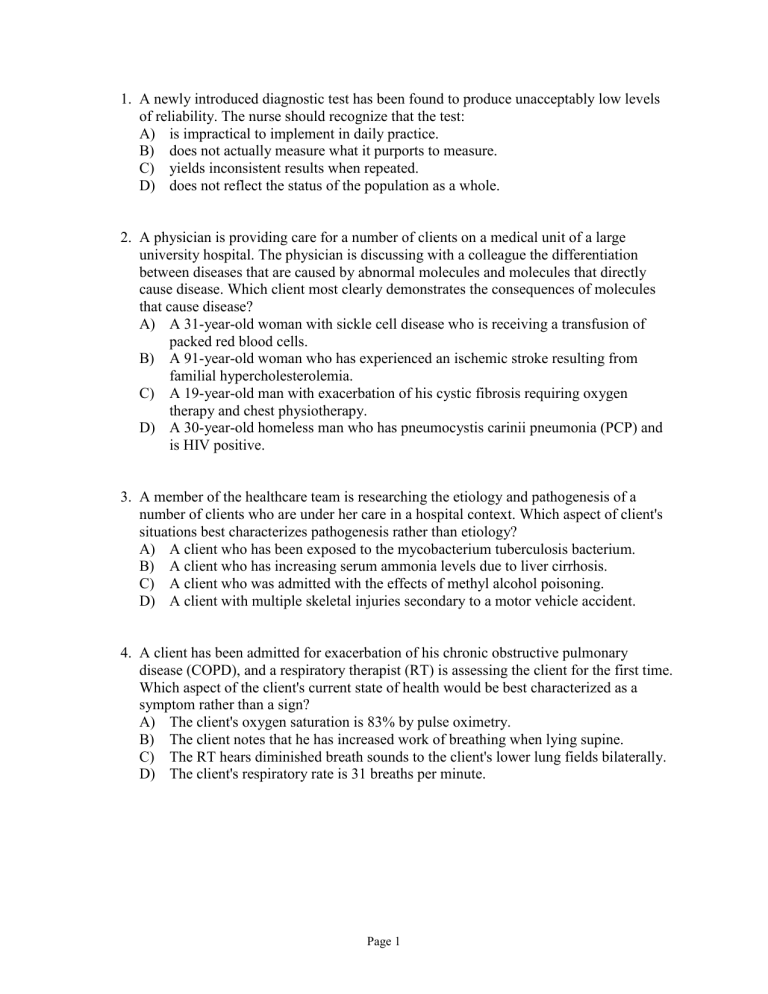
1. A newly introduced diagnostic test has been found to produce unacceptably low levels of reliability. The nurse should recognize that the test: A) is impractical to implement in daily practice. B) does not actually measure what it purports to measure. C) yields inconsistent results when repeated. D) does not reflect the status of the population as a whole. 2. A physician is providing care for a number of clients on a medical unit of a large university hospital. The physician is discussing with a colleague the differentiation between diseases that are caused by abnormal molecules and molecules that directly cause disease. Which client most clearly demonstrates the consequences of molecules that cause disease? A) A 31-year-old woman with sickle cell disease who is receiving a transfusion of packed red blood cells. B) A 91-year-old woman who has experienced an ischemic stroke resulting from familial hypercholesterolemia. C) A 19-year-old man with exacerbation of his cystic fibrosis requiring oxygen therapy and chest physiotherapy. D) A 30-year-old homeless man who has pneumocystis carinii pneumonia (PCP) and is HIV positive. 3. A member of the healthcare team is researching the etiology and pathogenesis of a number of clients who are under her care in a hospital context. Which aspect of client's situations best characterizes pathogenesis rather than etiology? A) A client who has been exposed to the mycobacterium tuberculosis bacterium. B) A client who has increasing serum ammonia levels due to liver cirrhosis. C) A client who was admitted with the effects of methyl alcohol poisoning. D) A client with multiple skeletal injuries secondary to a motor vehicle accident. 4. A client has been admitted for exacerbation of his chronic obstructive pulmonary disease (COPD), and a respiratory therapist (RT) is assessing the client for the first time. Which aspect of the client's current state of health would be best characterized as a symptom rather than a sign? A) The client's oxygen saturation is 83% by pulse oximetry. B) The client notes that he has increased work of breathing when lying supine. C) The RT hears diminished breath sounds to the client's lower lung fields bilaterally. D) The client's respiratory rate is 31 breaths per minute. Page 1 5. Nurses are discussing a new blood test that helps establish a differential diagnosis between shortness of breath with a cardiac etiology and shortness of breath with a respiratory/pulmonary etiology. A positive result is known to indicate a cardiac etiology. The marketers of the test report that 99.8% of clients who have confirmed cardiac etiologies test positive in the test. However, 1.3% of clients who do not have cardiac etiologies for their shortness of breath also test positive. Which statement best characterizes this blood test? A) Low validity, high reliability B) High sensitivity, low specificity C) High specificity, low reliability D) High sensitivity, low reliability 6. As part of a screening program for prostate cancer, men at a senior citizens centre are having their blood levels of prostate-specific antigen (PSA) measured. Which statement would best characterize high positive predictive value but low negative predictive value for this screening test? A) All of the men who had high PSA levels developed prostate cancer; several men who had low PSA levels also developed prostate cancer. B) All of the men who had low PSA levels were cancer free; several men who had high levels also remained free of prostate cancer. C) Men who had low PSA levels also displayed false-positive results for prostate cancer; men with high levels were often falsely diagnosed with prostate cancer. D) The test displayed low sensitivity but high specificity. 7. A particular disease has a debilitating effect on the ability of sufferers to perform their activities of daily living and is a significant cause of decreased quality of life. However, few people die as a result of the disease's direct effects. There are hundreds of thousands of Canadians living with the disease but relatively few new cases in recent years. This disease has: A) low mortality, high morbidity, low prevalence, and high incidence. B) low mortality, high morbidity, high incidence, and low prevalence. C) high mortality, low morbidity, high incidence, and low prevalence. D) high morbidity, low mortality, high prevalence, and low incidence. 8. A researcher has recruited a large number of mothers whose infants were born with cardiac defects, as well as mothers whose infants were born with healthy hearts. The researcher is comparing the nutritional habits of all the mothers while their babies were in utero. Which type of study is being conducted? A) Cohort study B) Randomized controlled trial (RCT) C) Case-control study D) Risk-factor study Page 2 9. A multidisciplinary healthcare team operates a program aimed at the prevention, identification, and treatment of diabetes in a rural community. Which aspect of the program would be most likely to be classified as secondary prevention? A) Regularly scheduled wound-dressing changes for clients who have foot ulcers secondary to peripheral neuropathy and impaired wound healing. B) Teaching schoolchildren how a nutritious, traditional diet can lessen their chances of developing adult-onset diabetes. C) Staffing a booth where community residents who are attending a baseball tournament can have their blood glucose levels checked. D) Administering oral antihyperglycemic medications to clients who have a diagnosis of diabetes. 10. An occupational therapist conducts a group therapy program called MindWorks with older adults who have diagnoses of dementia and Alzheimer disease. The goal of the group is to slow the cognitive decline of clients by engaging them in regular, organized mental activity, such as reading maps and solving puzzles. How would the program most likely be characterized? A) Primary prevention B) Secondary prevention C) Tertiary prevention D) Prognosis enhancement 11. The clinical educator of a hospital medical unit is establishing evidence-based practice guidelines for the nursing care on the unit. Which statement most accurately captures a guiding principle of the nurse's task? A) Evidence-based practice guidelines will be rooted in research rather than nurses' subjective practice preferences and experiences. B) Guidelines are synonymous with systematic research reviews. C) The need for continuity and standardization of guidelines will mean that they will be fixed rather than changeable. D) The guidelines will combine individual expertise with external systematic evidence. 12. To best understand the study of pathophysiology, the nurse must have a clear understanding of the term itself. Of the definitions below, which one best describes the term pathophysiology? A) The physiology of altered health B) Any deviation from or interruption of the normal structure or function of any part, organ, or system of the body C) Causes of disease D) Changes in structure or form that is characteristic of a disease Page 3 13. A physician is examining a 21-year-old college student who is exhibiting the classic symptoms of schizophrenia. In the course of her evaluation the physician begins developing a treatment strategy based on what she knows about the disease, available therapies, and medications. She also makes the client aware of the consequences of not following the treatment regimen. To accomplish this, what aspect of the disease is the physician using? A) Etiology B) Causation C) Natural history D) Morbidity statistics 14. A client has died and the nurse is responsible for filling out the death certificate. In performing this task, the nurse is required to record the client's age, sex, and cause of death, among other factors. What is the purpose of reporting these statistics? A) These statistics are recorded so pharmaceutical companies may compile the data to determine future need. B) The government requires the statistics in order to calculate the crude mortality rate. C) These statistics are useful in terms of anticipating healthcare needs, planning public-education programs, directing health research efforts, and allocating healthcare dollars. D) These statistics are required by the hospital to inform the WHO for the coding of the cause of death. 15. Researchers have designed a study where the health of a large group of babies will be followed for several years. What type of study is this? A) Repetition B) Double-blind placebo C) Case-control D) Cohort 16. A client has already suffered a heart attack and is placed on -blockers to reduce the workload on the heart, as well as a statin drug and a low-fat diet to lower cholesterol. This treatment plan is based on multiple levels; one is diet and statin therapy and the other is the use of -blockers. These therapies can be classified as: A) primary and secondary. B) secondary and tertiary. C) primary and tertiary. D) secondary and primary. Page 4 17. Which of the nurse's assessment questions most directly addresses the client's level of health, based on the World Health Organization's definition of health? A) “Would you consider yourself to be more healthy, less healthy, or average?” B) “What are the things that give you the most joy in your life?” C) “How often have you been sick over the past 12 months?” D) “How would you rate your overall sense of well-being?” 18. Which clients are exhibiting sequelae of disease? Select all that apply. A) A toddler who developed bronchiolitis after being treated for respiratory syncytial virus (RSV). B) A client who has just had a mastectomy to treat stage T3 breast cancer. C) A client who had serologic testing and who has found out that she is positive for human immunodeficiency virus. D) An older adult client who experienced liver failure after overdosing on acetaminophen in a suicide attempt. E) A client with diabetes who has developed a loss of vision. 19. An epidemiologist is working in a rural community that has experienced a sudden and alarming increase in the incidence of HIV/AIDS. What is the main focus of epidemiology in this context? A) Developing innovative treatments for HIV B) Examining patterns in the way that HIV is spreading C) Exploring the biochemical characteristics of the HIV virus D) Performing pharmacologic testing of antiretroviral drugs 20. In 2014, an outbreak of Ebola virus disease began in West Africa in which there was a sharp increase in the number of people being diagnosed with this disease. At the same time, a very high proportion of those who were diagnosed died from the disease. The epidemiologic characteristics of this disease include: A) high prevalence and increased incidence. B) increased incidence and high mortality. C) high morbidity and mortality. D) increased morbidity and high prevalence. Page 5 21. A client has been diagnosed with pancreatic cancer and is meeting with an oncologist for the first time. Which statement best describes the client's prognosis? A) “At the stage that your cancer is at, your likelihood of 5-year survival is around 10%.” B) “The plan of treatment will be based on the stage of your cancer, your response to therapy and your preferences.” C) “I've determined that your cancer is at stage IIB, which I'll explain to you.” D) “The formal name for what you have is pancreatic intraepithelial neoplasia III.” Page 6 Answer Key 1. 2. 3. 4. 5. 6. 7. 8. 9. 10. 11. 12. 13. 14. 15. 16. 17. 18. 19. 20. 21. C D B B B A D C C C D A C C D C D A, E B B A Page 7
